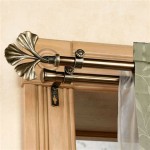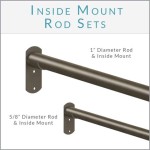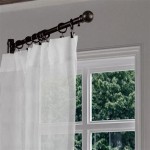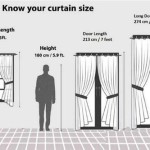Can You Hang Curtains Without a Drill? Exploring Drill-Free Curtain Hanging Options
Hanging curtains is a common household task that can significantly enhance the aesthetic appeal and functionality of a room. Curtains provide privacy, control light exposure, and contribute to the overall decor. Traditionally, installing curtains involved using a drill to create holes for mounting brackets, a process that can be daunting for some, particularly those unfamiliar with power tools or residing in rental properties where drilling is restricted. Fortunately, several drill-free alternatives exist for hanging curtains, offering convenient and damage-free solutions.
This article explores the various methods available for hanging curtains without a drill. It will delve into the different types of no-drill hardware, their applications, and considerations for selecting the most appropriate option based on window type, curtain weight, and desired aesthetic. The piece will also provide practical advice on installation techniques and potential limitations of each method.
Adhesive Hooks and Strips: A Versatile Solution for Lightweight Curtains
Adhesive hooks and strips represent a widely accessible and user-friendly alternative to drilling. These products utilize strong adhesives that bond to the wall surface, providing a secure point for hanging curtain rods or directly supporting lightweight curtains. The effectiveness of adhesive hooks and strips depends heavily on factors such as the weight capacity of the adhesive, the type of surface they are applied to, and the quality of the adhesive itself.
When selecting adhesive hooks or strips, it is crucial to carefully consider the weight of the curtains to be hung. Manufacturers typically specify the maximum weight capacity of their products, and exceeding this limit can lead to failure and potential damage. Choosing an adhesive rated for a weight slightly higher than the actual weight of the curtains provides an added margin of safety. Further, the surface preparation is essential. The area where the adhesive will be applied should be clean, dry, and free of dust or grease. Wiping the surface with isopropyl alcohol before application can improve adhesion.
Adhesive hooks come in various sizes and designs, accommodating different curtain rod diameters and aesthetic preferences. Some hooks are explicitly designed for curtain rods, featuring a curved shape to cradle the rod securely. Others are more generic and require the use of curtain rings or clips. Adhesive strips, on the other hand, typically require specialized curtain rod brackets that are designed to be mounted using adhesive. These brackets usually feature a flat surface on the back that adheres to the wall.
While adhesive hooks and strips offer a convenient solution, they are best suited for lightweight curtains like sheers or thin cotton panels. Heavier curtains, such as those made of velvet or blackout fabrics, may exceed the weight capacity of most adhesives, leading to potential failure. Also, it is worth noting that removing adhesive hooks or strips can sometimes damage the wall surface, especially if the paint is old or fragile. Using a hairdryer to gently warm the adhesive before removal can help minimize damage.
Tension Rods: A Simple and Adjustable Option for Inside Mounts
Tension rods offer a straightforward, drill-free solution for hanging curtains within a window frame. These rods utilize a spring-loaded or expandable mechanism to create pressure against the sides of the window frame, holding the rod securely in place. Tension rods are particularly well-suited for lightweight to medium-weight curtains, and they are an excellent option for renters or those who prefer a clean, minimalist aesthetic.
The installation of a tension rod is relatively simple. The rod is extended to a length slightly longer than the width of the window frame. Then, the rod is compressed to fit snugly inside the frame, creating the necessary tension to hold it in place. The rubber or plastic end caps on the rod provide friction and protect the window frame from damage.
Several factors should be considered when selecting and using tension rods. First, the diameter of the rod is important. Thicker rods generally provide greater stability and can support heavier curtains. Secondly, the weight capacity of the rod should be carefully considered. Most tension rods have a specified weight limit, and exceeding this limit can cause the rod to slip or collapse. Thirdly, the type of window frame can affect the suitability of tension rods. The frames should be sturdy and in good condition to provide adequate support. Painted or varnished frames may offer better grip compared to smooth or glossy surfaces. In addition, very wide windows might necessitate the use of a heavier-duty tension rod or a combination of two rods for added support.
Tension rods are typically used for inside-mount curtains, meaning the curtains are installed within the window frame. This creates a clean, streamlined look and maximizes the amount of natural light that enters the room. However, tension rods can also be used for outside-mount curtains in some cases. This requires the use of specialized tension rod brackets that attach to the wall using adhesive or other non-drilling methods. However, outside-mount applications may reduce the overall stability and weight-bearing capacity.
While tension rods offer a convenient and drill-free solution, they have some limitations. They are generally not suitable for heavy curtains, such as those made of blackout fabrics or thick drapes. Also, the weight distribution across the rod needs to be reasonably even to prevent sagging or slipping. Frequent adjustments or movement of the curtains can also loosen the tension, requiring periodic readjustment of the rod.
Magnetic Rods: A Unique Solution for Metal Surfaces
Magnetic curtain rods provide a unique and straightforward solution for hanging curtains on metal surfaces, such as metal doors, refrigerators, or filing cabinets. These rods utilize strong magnets that adhere to the metal surface, providing a secure and drill-free mounting point. Magnetic rods are particularly useful in areas where drilling is not possible or practical, such as in dorm rooms, offices, or temporary living spaces.
The strength of the magnets is a crucial factor to consider when selecting magnetic curtain rods. The magnets must be strong enough to support the weight of the curtains without slipping or falling. Manufacturers typically specify the weight capacity of their magnetic rods, and it is essential to choose a rod with a weight rating that exceeds the actual weight of the curtains. It is also worth considering the type and thickness of the metal surface. Some metals, such as aluminum, are not magnetic, while others may have varying degrees of magnetic attraction. Thicker metal surfaces generally provide a stronger magnetic connection.
Magnetic rods are available in various lengths and styles to accommodate different curtain sizes and aesthetic preferences. Some rods feature adjustable lengths, allowing them to be customized to fit specific window or door dimensions. Others are designed for specific types of curtains, such as cafe curtains or valances. The installation of magnetic rods is very simple. The rod is simply attached to the metal surface, ensuring that the magnets are firmly in contact with the metal.
While magnetic rods offer a convenient and drill-free solution for metal surfaces, they have some limitations. They are obviously restricted to metal surfaces. The weight capacity can be a limiting factor, as very heavy curtains may exceed the strength of the magnets. Also, the magnets can sometimes leave marks or scratches on the metal surface, especially if the rod is frequently moved or adjusted. Using protective pads or coverings on the magnets can help prevent damage.
Furthermore, the magnetic attraction can be affected by factors such as temperature and humidity. Extreme temperatures or high humidity can weaken the magnetic bond, potentially causing the rod to slip or fall. It is advisable to avoid using magnetic rods in environments with extreme temperature fluctuations or high humidity levels.
In summary, hanging curtains without a drill presents several viable options, each suited to different requirements and circumstances. Adhesive hooks and strips offer versatility for lightweight curtains on smooth surfaces. Tension rods excel for inside-mount applications with moderate weight considerations. Magnetic rods provide a unique solution for metal surfaces. Carefully considering these factors before choosing an installation method ensures both successful curtain hanging and preservation of wall or window frame integrity. These drill-free solutions offer accessibility and convenience, making curtain installation a manageable task for a wide range of individuals and living situations.

How To Hang Curtains Without Drilling

How To Hang A Curtain Rod Without Drilling Into The Wall

4 Easy Ways To Hang Curtains Without Drilling

Hanging Indoor Curtains Outside Without Drilling Holes

How To Hang Curtains Without Drilling 8 Creative Ideas Hanging Curtain Rods

How To Hang Curtains Without Drilling

4 Easy Ways To Hang Curtains Without Drilling

Easy Ways To Hang Curtains Without Drilling 15 Steps

How To Hang Curtains Without Holes Using Command Hooks Great Idea For Ers Or Students Who Don T W Hanging Al Decorating

Easy Ways To Hang Curtains Without Drilling 15 Steps








